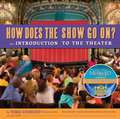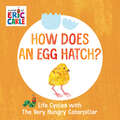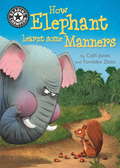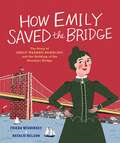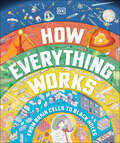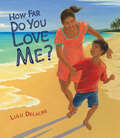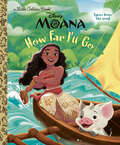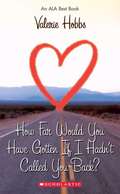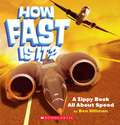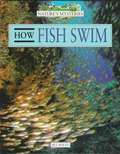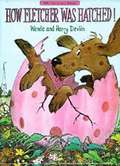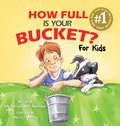- Table View
- List View
How Does Santa Go Down the Chimney?
by Mac BarnettWhen Santa arrives at a child’s house on Christmas Eve, does he go down the chimney feetfirst or headfirst? What if he gets stuck? What if there’s no chimney? Maybe he slides under the door, as thin as a piece of paper? Or is it possible he pours himself through the faucet? What happens once he’s inside? Whether it’s shape-shifting or impromptu laundry use, Mac Barnett’s iconic talent for earnest deadpan humor and Jon Klassen’s irresistibly funny art honor the timeless question with answers both ridiculous and plausible, mounting in hilarity as the night continues. Channeling a child’s fanciful explanations (and begging for further speculation), this latest collaboration by a New York Times best-selling team will find a secure spot among family holiday traditions.
How Does Streaming Work? (High Tech Science at Home)
by M. M. EbochWhether you're watching a movie, bingeing on a classic TV show, or listening to your favorite song, you're probably streaming it. Videotapes, DVDs, and CDs are mostly just memories now. Streaming puts a world of options at your fingertips when you’re at home and, with a smartphone or tablet, when you're on the go. Find out how streaming was invented, how it works, and what the future might hold for this part of a high-tech life.
How Does The Show Go On?: An Introduction To The Theater (A Disney Theatrical Souvenir Book)
by Jeff Kurtti Thomas SchumacherFilled with detailed explanations, captivating illustrations, and entertaining trivia, this clearly written, lively, and uniquely-designed book is a first-of-its-kind introduction to the world of the Theatre, from the box office to backstage, and beyond. From one side of the book, the reader enters via the front door, where the people and activities of the “front of house” can be examined. From the book’s other side, the reader enters the “Stage Door,” where the behind-the-scenes world of the “Back of house” is revealed. In exploring this visually-inviting “theatre of the mind,” readers encounter the people, places, occupations, and equipment of the theatre world, and have the opportunity to investigate them all. From the box office and the Usher Staff to the Dressing Rooms and the Backstage doorman, the reader may wander at will within this one-of-a-kind world, discovering the wonders of theatre all along the way.
How Does Wi-Fi Work? (High Tech Science at Home)
by Mark WeaklandYou probably use Wi-Fi all the time to connect to the internet through your laptop, tablet, or phone. It's easy. Wi-Fi hotspots surround you as you go through your day - from school to a pizza place or coffee shop and then back home. Not so long ago, the internet wasn't as accessible. Find out how Wi-Fi works, how it became commonplace, and what it might do for you in the future.
How Does a Caterpillar Change?: Life Cycles with The Very Hungry Caterpillar (The World of Eric Carle)
by Eric CarleLearn how a caterpillar turns into a butterfly with the help of The Very Hungry Caterpillar!In this nonfiction story, young readers can explore the transformation of a caterpillar into a butterfly. The miracles of nature come to life in this early-learning series centered around life cycles, featuring simple text and Eric Carle's classic illustrations!
How Does a Czar Eat Potatoes?
by Janosch Anne K. RoseRose cleverly translates Janosch's book, in which the czar drinks tea from a sugar-loaf while the peasant father only dreams of sugar. Children will appreciate the poetic style, while grown-ups will think: how true are these life contrasts. "And your father, how does he bathe? My father, bathe? In the summer when it's hot The river awaits him. In the winter when it's cold He waits for summer. And that's the way, that's the way My father bathes."
How Does a Seed Sprout?: Life Cycles with The Very Hungry Caterpillar (The World of Eric Carle)
by Eric CarleLearn how a seed becomes a tree with Eric Carle's classic artwork and The Very Hungry Caterpillar!In this nonfiction story, young readers explore the transformation of a seed into a tree. The miracles of nature come to life in this early-learning series centered around life cycles, featuring simple text and Eric Carle's classic illustrations!
How Does a Smoke Detector Work?
by Liz HuyckEver wonder why a smoke alarm goes off? A battery, siren, and metal can work together to detect smoke and sound the alarm when catching a whiff of smoke.
How Does a Tadpole Grow?: Life Cycles with The Very Hungry Caterpillar (The World of Eric Carle)
by Eric CarleLearn how a tadpole becomes a frog with Eric Carle's classic artwork and The Very Hungry Caterpillar!In this nonfiction story, young readers explore the transformation of a tadpole into a frog. The miracles of nature come to life in this early-learning series centered around life cycles, featuring simple text and Eric Carle's classic illustrations!
How Does a Tree Help? (Into Reading, Level B)
by David Bauer<p>NIMAC-sourced textbook <p>All kinds of animals make their homes in trees. Children do, too!</p>
How Does an Egg Hatch?: Life Cycles with The Very Hungry Caterpillar (The World of Eric Carle)
by Eric CarleLearn how an egg becomes a baby chick with Eric Carle's classic artwork!In this nonfiction story, young readers explore the transformation of an egg into a chick. The miracles of nature come to life in this early-learning series centered around life cycles, featuring simple text and Eric Carle's classic illustrations!
How Dumb Can You Get (Junior High #4)
by Kate KenyonCAN NORA REALLY FIX ANYTHING? From the class dunce in shop, Nora has become the class star. Now that she understands mechanics, she can fix anything, except the attitude of her handsome shop partner, Brad. Did he really only like her when she couldn't tell a nut from a bolt? Spacey Tracy advises Nora to be dumb again to regain Brad's interest. Nora's best friend, Jen, is disgusted by the advice, but Nora is not so sure. Then on a class trip, an emergency puts Nora to the test: Is it really smarter to play dumb?
How Elephant Learnt Some Manners: Independent Reading 12 (Reading Champion #511)
by Cath JonesThis story is part of Reading Champion, a series carefully linked to book bands to encourage independent reading skills, developed with Dr Sue Bodman and Glen Franklin of UCL Institute of Education (IOE). This book is aimed at Independent Reading 12, for readers aged 7 years old and up, or in the second half of Year 3.Elephant is the biggest and also thinks he's the best. He's always a bit rude to the other animals, until some clever squirrels teach him a lesson.Reading Champion offers independent reading books for children to practise and reinforce their developing reading skills.Fantastic, original stories are accompanied by engaging artwork and a reading activity. Each book has been carefully graded so that it can be matched to a child's reading ability, encouraging reading for pleasure.The Key Stage 2 Reading Champion Books are suggested for use as follows:Independent Reading 11: start of Year 3 or age 7+Independent Reading 12: end of Year 3 or age 7+Independent Reading 13: start of Year 4 or age 8+Independent Reading 14: end of Year 4 or age 8+Independent Reading 15: start of Year 5 or age 9+Independent Reading 16: end of Year 5 or age 9+Independent Reading 17: start of Year 6 or age 10+Independent Reading 18: end of Year 6 or age 10+
How Emily Saved the Bridge: The Story of Emily Warren Roebling and the Building of the Brooklyn Bridge
by Frieda WishinskyThe amazing story of Emily Warren Roebling, the woman who stepped in to oversee the construction of the Brooklyn Bridge, which was completed in 1883.Emily was not an engineer, but she was educated in math and science. She married Washington Roebling, the chief engineer of the famous bridge. When Washington became ill from decompression sickness, Emily stepped in, doing everything from keeping the books, to carrying messages for her husband, to monitoring the construction of the bridge. She was the first person to cross the Brooklyn Bridge when it opened.Emily, who went on to study law among many other accomplishments, is an inspiration to all, as demonstrated through Frieda Wishinsky’s informative and engaging text and Natalie Nelson’s distinctive collage illustrations. Speech bubbles revealing imagined dialogue add a playful note to this historical account, which includes fascinating facts about the Brooklyn Bridge and a further reading list.Key Text Featuresfurther readingspeech bubblesCorrelates to the Common Core State Standards in English Language Arts:CCSS.ELA-LITERACY.RL.2.1Ask and answer such questions as who, what, where, when, why, and how to demonstrate understanding of key details in a text.CCSS.ELA-LITERACY.RL.4.3Describe in depth a character, setting, or event in a story or drama, drawing on specific details in the text (e.g., a character's thoughts, words, or actions).
How Everything Works
by DKDiscover an all-in-one encyclopedia that takes you on an explanatory tour of the world from your own body to outer space.Have you ever wondered how an email gets to someone on the other side of the world in just a few seconds or why it&’s a bad idea to stand under a tree during a thunderstorm? Discover the answers to all these questions and more with these mind-boggling how things work books for children aged 9 and above!Each page of this mind-blowingly detailed and ambitious encyclopedia will guide you through the natural world and the technology that surrounds you. Giant, page-filling illustrations take objects apart – or take the roofs and walls off buildings – to show you how they work, explaining both basic principles (such as photosynthesis) as well as broader concepts (like how all the living things in a rainforest interact). Explore each and every page of this engaging how things work book to discover:- Key insights into both the natural and human worlds- Striking photography that brings certain concepts to life- A diverse range of chapters coinciding with STEM subjects at school In this how things work encyclopedia, chapters range from the human body to cities and industry, to planet Earth, taking in sleep patterns, cooking, sewage systems, wind farms, fungi spores, and plate tectonics along the way. How Everything Works is perfect for children studying STEM subjects at school or anyone who is simply curious about how nature and the modern world work.
How Far Do You Love Me?
by Lulu Delacre<p>Based on a bedtime game author/illustrator Lulu Delacre played with her young daughters, How Far Do You Love Me? is an “I love you” book with a twist. <p>With every expression of love, readers visit one of thirteen different locations around the world, each a beautifully illustrated scene of adults and children in a place of natural beauty. <p>Guided Reading: K; Lexile: AD650L; Interest Level: Grades PreK - 3; Reading Level: Grades 2 - 3; Themes: Colors, Nature/Science, Multi-ethnic interest, Environment/Nature, Cultural Diversity, Childhood Experiences and Memories, Empathy/Compassion, Gratitude, Optimism/Enthusiasm, Realistic Fiction, Water</p>
How Far Do You Love Me?
by Lulu DelacreThis unique bedtime book by award-winning author-illustrator Lulu Delacre features a game that highlights the universal love between caregivers and children while taking readers on a journey across the seven continents of Earth.How far do you love me?I love you to the top of the peakslit by the morning sun ...To the crests of the desert where the wind sweeps sand from the dunes ... Based on a bedtime game that author-illustrator Lulu Delacre played with her young daughters, How Far Do You Love Me? is an "I love you" book with a twist. With every expression of love, readers visit a different location around the world, each a beautifully illustrated scene of caregivers and children in a place of natural beauty. The intimate size of the book is just right for sharing and snuggling up close with a child. As bedtime--or any quiet time--approaches, gather close with a special person in your life and get ready to let your imagination soar to place after place as you embark on a game of "How far do you love me?" The possibilities are endless!
How Far I'll Go (Little Golden Book)
by Golden BooksSing along to the lyrics from &“How Far I&‘ll Go&” from Disney Moana in this beautifully illustrated Little Golden Book!Set sail and join Disney Princess Moana as she dreams about the world beyond her island! This beautiful Little Golden Book features the lyrics to the beloved song &“How Far I&’ll Go&” from Disney Moana, written by Lin-Manuel Miranda. With illustrated scenes from the hit movie, this book is sure to be a favorite for children ages 2 to 5 as well as Disney fans and Little Golden Book collectors of all ages.Little Golden Books enjoy nearly 100% consumer recognition. They feature beloved classics, hot licenses, and new original stories. . . the classics of tomorrow.
How Far Will I Fly?
by Sachi OyamaA young boy asks many questions of his grandmother. She answers each one simply.
How Far Would You Have Gotten If I Hadn't Called You Back?
by Valerie HobbsWhen 16-yr-old Bronwyn Lewis's family uproots itself and moves across the country to sleepy Ojala, California, Bron is caught off-guard by the effortless cool of her new classmates. In order to make it in Ojala, Bron will have to remake herself. And so she does, putting aside her studies to drag race, hang out, and meet boys. Soon she's involved in an intense love triangle -- with no easy solutions.
How Fast Is It?: A Zippy Book All About Speed
by Ben HillmanIn this third book by Ben Hillman, young readers will learn and see just how fast something is. By comparing objects such as the Thrust SSC (that's a Thrust-powered Super Sonic Car), an ostrich (don't underestimate the ostrich, my friend!), the human brain, and bamboo,wildly different objects are taken out of normal context and placed next to one another to allow for new and exciting perspectives. So just how fast is an ostrich? An ostrich would beat a top-notch professional cyclist in a ten-mile (sixteen km) race, hands down! While the best cyclists can race at blistering speeds of twenty-five miles per hour, the ostrich can run at forty-five miles per hour! Other books in the series that kids will enjoy: How Big Is It? and How Strong Is It?
How Fish Swim (Nature's Mysteries Series)
by Jill BaileyIntended as reference for school projects in a variety of curriculum areas, this book explains how fish swim. It is one of a series about many of the most amazing aspects of nature that aims to provide 8-12 year olds with an understanding of how nature works.
How Fletcher Was Hatched
by Wende Devlin Harry DevlinFletcher is a large hound dog with brown spots, and his mistress is a little girl named Alexandra. The trouble starts because Alexandra is interested in baby chicks - tiny, fluffy, yellow chicks that say "Peep!" as they come out of their shells. Fletcher's water dish is empty. He hasn't had his ears scratched in days. "She's forgotten me," he decides, and mournfully he shuffles off to the park at the edge of town. Here Fletcher's good friends, Beaver and Otter, have the idea. Fletcher must hatch! Of course, Beaver is a master builder, and it's no trouble at all to build an egg around Fletcher. The egg is large and pink and speckled with brown, and it poses somewhat of a problem for the school principal, not to mention the science teacher. But young readers will delight in the hilarious climax, along with a little girl named Alexandra. This file should make an excellent embossed braille copy.
How Frogs Grow (Fountas & Pinnell LLI Green #Level G, Lesson 79)
by Stanley FrancisFountas and Pinnell Leveled Literacy Intervention Green System -- 1st Grade
How Full Is Your Bucket? For Kids
by Tom Rath Mary Reckmeyer Maurie J. ManningThrough the story of a little boy named Felix, this charming book explains to children how being kind not only helps others, it helps them, too. As he goes about his day, Felix interacts with different people - his sister Anna, his grandfather, other family and friends. Some people are happy, but others are grumpy or sad. Using the metaphor of a bucket and dipper, Felix’ grandfather explains why the happy people make Felix feel good, while the others leave him feeling bad - and how Felix himself is affecting others, whether he means to or not. This beautifully illustrated adaptation takes the original book’s powerful message - that the way we relate to others has a profound effect on every aspect of our lives - and tailors it to a child’s unique needs and level of understanding.


